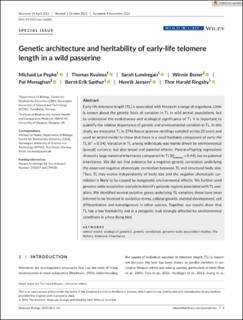| dc.description.abstract | Early-life telomere length (TL) is associated with fitness in a range of organisms. Little is known about the genetic basis of variation in TL in wild animal populations, but to understand the evolutionary and ecological significance of TL it is important to quantify the relative importance of genetic and environmental variation in TL. In this study, we measured TL in 2746 house sparrow nestlings sampled across 20 years and used an animal model to show that there is a small heritable component of early-life TL (h2 = 0.04). Variation in TL among individuals was mainly driven by environmental (annual) variance, but also brood and parental effects. Parent-offspring regressions showed a large maternal inheritance component in TL (urn:x-wiley:09621083:media:mec16288:mec16288-math-0001 = 0.44), but no paternal inheritance. We did not find evidence for a negative genetic correlation underlying the observed negative phenotypic correlation between TL and structural body size. Thus, TL may evolve independently of body size and the negative phenotypic correlation is likely to be caused by nongenetic environmental effects. We further used genome-wide association analysis to identify genomic regions associated with TL variation. We identified several putative genes underlying TL variation; these have been inferred to be involved in oxidative stress, cellular growth, skeletal development, cell differentiation and tumorigenesis in other species. Together, our results show that TL has a low heritability and is a polygenic trait strongly affected by environmental conditions in a free-living bird. | en_US |

